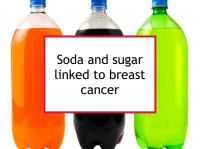High intakes of added sugar (sucrose), soda and other foods with a high glycemic index have been linked to increased risk of breast cancer and reduced survival. On the other hand, dietary fiber has been shown to counteract these effects to some extent. Now a new study has calculated the effects of sugar and soda intake on risk and the ameliorating effects of fiber.
Diets dominated by high glycemic index foods have a high glycemic load. Women in the highest quintile of glycemic load in one study were found to have 1.45 times the risk of breast cancer as those in the lowest quintile. Increasing intakes of sugar-sweetened beverage or foods is associated with increasing breast density, an important breast cancer risk factor. High sugar diets are associated with obesity, another breast cancer risk factor. However, even lean women without type 2 diabetes and who are not insulin resistant are more likely to develop breast cancer if they consume a significant proportion of their calories in the form of sugar.
Latest research quantifies risk of high sugar
The major prospective Mexican study referenced above was designed to investigate the associations of added sugar, soda intake, glycemic index and glycemic load, and dietary fiber with breast cancer risk in women from the Mexican Teachers’ Cohort. The study included 89,879 initially cancer-free women from 12 Mexican states. Diet was assessed during 2006 to 2008 using a validated food frequency questionnaire. Breast cancer cases were identified through medical records and cancer registries until December 2019. The women were followed for a median of 10.9 years, during which time a total of 1,313 breast cancer cases were identified.
Participants were divided into four groups (quartiles) based on their daily added sugar intake (≤26, 27-52, 53-78, ≥79 g). They were also divided into quartiles based on daily fiber intake (<25, 25-30, 30-35, ≥35 g), into quintiles based on weekly soda consumption (≤0.5, 0.6-1.5, 1.6-2.5, 2.6-4.0, ≥4.1 servings) and quintiles based on glycemic index and glycemic load. Results were adjusted for socioeconomic status, reproductive history, level of physical activity, and dietary covariates.
Median added sugar intake was 52 g/day. Higher added sugar intake (53-78 g/day) was found to be associated with 27% increased risk of breast cancer overall and 39% increased risk among premenopausal women. High glycemic index was associated with 57% increased breast cancer risk among postmenopausal women in the third quintile, and high glycemic load was associated with 41% increased risk among premenopausal women in the highest quintile.
Soda was the main source of added sugars for the study participants — soda consumption was found to be an important contributor to breast cancer risk. Those consuming ≥4 servings/week had 25% increased risk of breast cancer compared to those who consumed ≤0.5 servings/week. Fiber intake appeared to protect against sugar intake. Compared to <25 g/day, Those consuming ≥35 g/day fiber were found to have 21% reduced breast cancer risk (multivariable adjustments consistently supported this association).
The authors conclude that high added sugar and soda consumption, in combination with high glycemic index and glycemic load dietary patterns, increase breast cancer risk among Mexican women. Increased fiber intake appears to be protective. Reducing soda and added sugar consumption and increasing dietary fiber should be public health priorities to lower breast cancer incidence in the Mexican population, according to the authors.
Please see our articles on glycemic load and fiber for more information.
